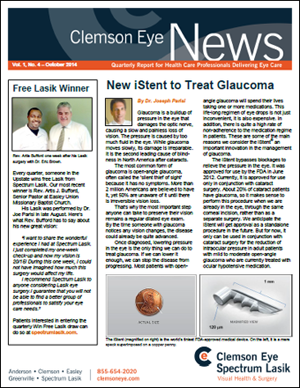Posted by: Clemson Eye in News

Clemson Eye News, October 2014
Click here to view and download the PDF
Glaucoma is a buildup of pressure in the eye that damages the optic nerve, causing a slow and painless loss of vision. The pressure is caused by too much fluid in the eye. While glaucoma moves slowly, its damage is irreparable. It is the second leading cause of blind-ness in North America after cataracts.
The most common form of glaucoma is open-angle glaucoma, often called the ‘silent thief of sight’ because it has no symptoms. More than 2 million Americans are believed to have it, yet 50% are unaware of it until there is irreversible vision loss.
That’s why the most important step anyone can take to preserve their vision remains a regular dilated eye exam.
By the time someone with glaucoma notices any vision changes, the disease could already be quite advanced.
Once diagnosed, lowering pressure in the eye is the only thing we can do to treat glaucoma. If we can lower it enough, we can stop the disease from progressing. Most patients with open-
angle glaucoma will spend their lives taking one or more medications. This life-long regimen of eye drops is not just inconvenient, it is also expensive. In addition, there is quite a high rate of non-adherence to the medication regime in patients. These are some of the main reasons we consider the iStent® an important innovation in the management of glaucoma.
The iStent bypasses blockages to relieve the pressure in the eye. It was approved for use by the FDA in June 2012. Currently, it is approved for use only in conjunction with cataract surgery. About 20% of cataract patients have glaucoma, so it makes sense to perform this procedure when we are already in the eye, through the same corneal incision, rather than as a separate surgery. We anticipate the iStent will get approval as a standalone procedure in the future. But for now, it only can be used in conjunction with cataract surgery for the reduction of intraocular pressure in adult patients with mild to moderate open-angle glaucoma who are currently treated with ocular hypotensive medication.
If you have glaucoma, over time your eye’s natural drainage system becomes clogged. The iStent creates a perma-nent opening through the blockage to improve the eye’s natural fluid outflow.
The iStent is tiny. It is the smallest medical device ever approved by the FDA. At 1 millimeter long and just a third of a millimeter high, it requires advanced ophthalmic operating microscopes to “visualize the anatomy” and place the device in the eye.
Implanting the iStent does not significantly lengthen the time a patient spends in surgery and has a safety profile comparable to cataract surgery alone.1 The stent helps control eye pressure while reducing or eliminating the need for drops. This is a significant advantage, as it helps address the high rate of medication non-compliance among glaucoma patients.
As many as 90% of patients do not adhere to their prescribed regimen of drops and more than half stop using them completely. This is a serious problem as when pressure in the eye is out of control, it can increase the risk of permanent vision loss.
So far, iStent results have been very positive with about 68% of patients remaining medication free 12 months after their procedure.2
The bottom line is this new, inno-vative stent provides an opportunity to safely reduce intraocular pressure. As an iStent-trained surgeon, I now offer this solution to glaucoma patients who come to me for cataract surgery.
We at Clemson Eye are proud to be in the first wave of ophthalmologists using this procedure, which can signifi-cantly improve quality of life for glau-coma patients.
Implanting the iStent during cataract surgery is covered by most insurance plans, Medicare and Medicaid.
Dr. Joe Parisi is Chief
Ophthalmologist and Medical Director at Clemson Eye.
1. Saheb H, Ahmed II. Micro-invasive glaucoma surgery: current perspectives and future directions. Curr Opin Ophthalmal. 2012;23(2):96-104.
2. Samuelson, et al. US IDE Trial – IOP and Medication Reduction. Ophthalmology 2011;118:459-467.